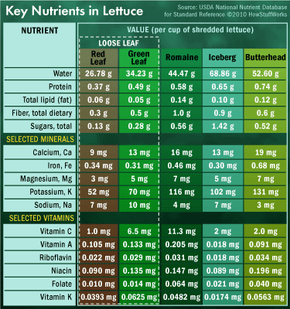We all know why Popeye the Sailor was strong to the finish, and it wasn't weight training. It was because of spinach, one of the healthiest members of the dark green vegetable subgroup. Here's something you may not have known: Although spinach looks like lettuce and often finds itself near lettuce in our salad bowls, it's not lettuce. It belongs to the Amaranthaceae family, which also includes beets, quinoa and tumbleweeds. Lettuce, on the other hand, belongs to the Compositae, or daisy, family, the largest group of vascular plants.
According to some history books, lettuce first appeared near the Mediterranean basin more than 4,000 years ago. Ancient humans may have treated this leafy, low-growing plant as a nuisance and plucked it from their gardens like any weed. Gradually, however, they discovered the value of lettuce (and salads) as a food source and began cultivating the plant. Christopher Columbus carried lettuce on his voyages and introduced it to the New World, where it became a popular crop.
Advertisement
Over the years, farmers have developed many varieties of lettuce with many forms, textures and colors. Most fall into one of four categories -- crisphead, romaine (or cos), butterhead and loose-leaf. Crisphead lettuces include the iceberg strains, favorites in the United States. Romaine lettuce is another popular variety, especially as the key ingredient of Caesar salads. The two most common butterheads are Boston lettuce and bibb lettuce, both of which produce loose heads with small, tender leaves. Loose-leaf lettuces, on the other hand, don't grow to form true heads, but have leaves joined at the stem. This group includes green-leaf, red-leaf and oak-leaf lettuce.
But which one of these salad starters would be considered the healthiest? One clue can be found in the color of the leaves. The more they look like Popeye's dark-green spinach, the more vitamins and minerals they're likely to contain. Does that make romaine and butterhead lettuces healthier than crisphead kinds? On the next page, we'll use hard nutritional data to see if we can answer the question more precisely.
Advertisement


